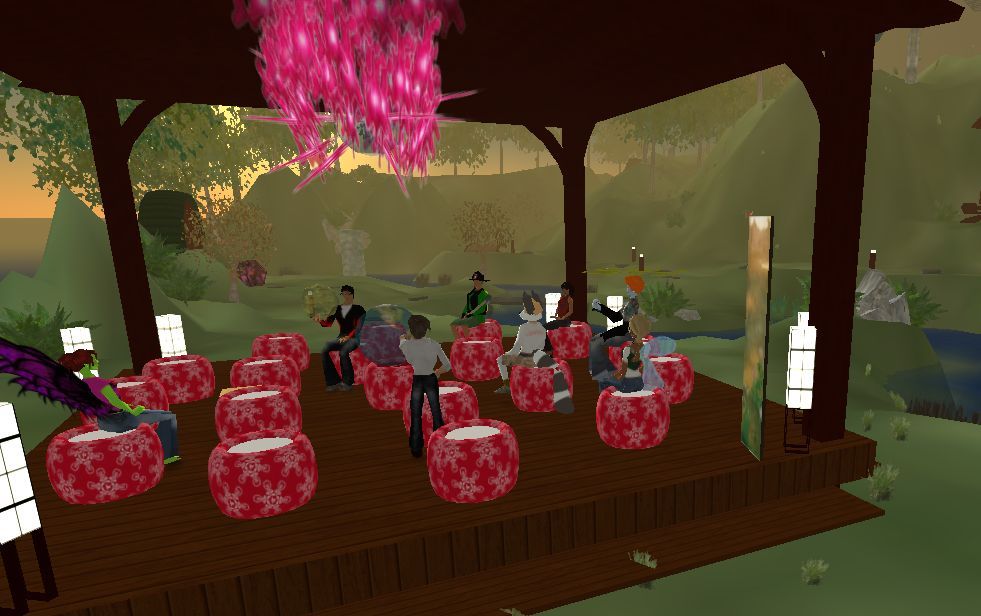First Schome paper
So our first paper from the Schome Park Pilot has been published! This one was based upon the initial data that we collected in our early days in Second Life. The basic jist of it is that Second Life works well for distance learning 🙂 If you are interested in what we did have a read of the paper. I image that this will be my only publication in an educational journal!
Virtual satellite becoming a reality?
Imagine a place where a giant raccoon can sit in a Japanese garden next to a green lady with wings, designing a satellite experiment with high school students from all over the country. This may sound like the deluded babblings of a mad man, but such a place really exists. Well, virtually. This place is Schome Park, and I am that raccoon.
Schome Park is a private island on the teen grid of Second Life®. It is owned by a group of researchers at the Open University exploring the cutting edge of educational theory. With over one hundred schools across the U.K. (and more in the U.S.A.) registered in Schome Park, we are toying with the very foundations of education as we know it.
Second Life is a virtual world where residents can create whatever objects they can imagine, programming them to behave however they wish. Each resident has an avatar that they can personalise; we have had everything from a brain in a jar to people with blue skin. This allows a degree of anonymity that breaks down any social barriers built by real life communication. The only departure from this anonymity is the distinction between adults and those under 18 via their avatar surname. One of the fundamental ideas behind Schome Park is that everyone can, and should, teach everyone else. It’s an idea that works, with the majority of activities being student-led and evaluated, giving them the responsibility of moulding their own education.
In collaboration with the Schome educational researchers, we (a couple of space science Ph.D. students also at the Open University) have successfully used this virtual world to engage teenagers in space science. We have entered a student team in a national competition run by Surrey Satellite Technology Ltd. (SSTL) and The British National Space Centre to design a satellite instrument for launch in 2010.
Exploiting the virtual environment of Second Life means we have not been restricted by the limitations of the real world – a great advantage when designing things that are out of this world! Using aspects of this virtual environment, and the supporting Schome forum and wiki, we have overcome our geographical separation and proposed an instrument to record Earthshine from Low-Earth Orbit.
Earthshine is sunlight reflected off the Earth onto the Moon. We have built scale models of the Sun-Earth-Moon system in-world, to understand the scientific principles behind the Earthshine phenomenon and the proposed instrument. The instrument (S.C.H.O.M.E. – Spectroscopy, Climate and Habitability from Orbital Measurement of Earthshine) comprises a spectrometer currently being adapted for the ESA ExoMars mission combined with simple optics. This will take albedo measurements from the Earth, and its apparent “signature”, as would be seen from outside the Solar System, can be obtained. More specifically, the instrument will record in the visible/near infra red wavelength range, where features of minerals/soils, vegetation, oxygen, water and ozone are visible, some of which are key indicators of life.
The application of measurements from the S.C.H.O.M.E. instrument are two-fold. Firstly, our proposed instrument can record the signatures of the only planet we know that harbours life. Earthshine measurements can therefore serve as a reference for assessing the nature of and the habitability of exoplanets. This ties in with the big budget missions such as ESA’s CoRoT & Darwin and NASA’s Terrestrial Planet Finder and New Worlds Mission which are all directed to discover exoplanets and assess their habitability. Secondly, such Earthshine measurements can also be input to climate models. This will help us to assess solar heating effects due both to albedo and specific spectral absorption features of components of surface cover, thus aiding our understanding of our changing planet.
Having been selected as one of six finalists in the competition, we have been working with engineers from SSTL and more scientists at The Open University to develop the instrument further, and have just submitted the final proposal. With restrictions on mass, space, power and money (100g, 10cm3, 1W and a £100,000 development budget) will our virtual satellite become a reality? The winner is announced at the IAF in Glasgow on the 3rd October. So, watch this (virtual) space!
To find out more visit www.schome.ac.uk

